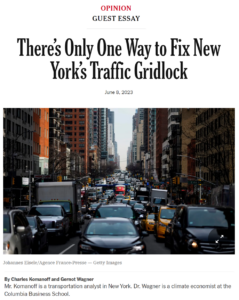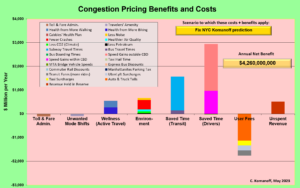The New York Times yesterday published my op-ed, There’s Only One Way to Fix New York’s Traffic Gridlock, co-written with Columbia University climate economist Gernot Wagner.
Our essay is a meticulous and extensive (1,300 words) brief for making drivers feel the pocketbook costs of their vehicles’ traffic-jam causation, via the policy measure known as congestion pricing. In our telling, not only is this policy guaranteed to generate immense benefits for New Yorkers; as the title suggests, we declare it to be the only way to “free … drivers from the traffic snarls that pollute the air and crush the soul.”

From the Times’ home page, June 8, 2023.
The essay was nearly a month in the making and the product of extensive argument-shaping and fact-checking by the Times’ op-ed staff, bespeaking the paper’s commitment to presenting congestion pricing in a positive light. Its appearance broke the mold of the paper’s hesitant past coverage in two important respects:
1. It explicitly rests on the “comprehensive spreadsheet model” of New York traffic and transit I began developing in 2007 (coincidentally, the year I launched the Carbon Tax Center).
2. It let Gernot and me voice the inconvenient assertion that the regional transit agency charged with designing and administering congestion pricing — the Metropolitan Transportation Authority — “through a few fateful, faulty assumptions, underestimated drivers’ propensity to switch trips from cars to other transit options.” These flubs have tied congestion pricing advocates in knots, forcing us to rebut objections of environmental justice impacts that don’t stand careful scrutiny, although they understandably resonate with communities that historically have borne hugely disproportionate damages from highways, energy facilities and other polluting infrastructure.
It’s only a modest stretch to view the Times’ twin breaks with tradition as the Grey Lady’s version of Andrew Cuomo’s bombshell announcement in August 2017 that “congestion pricing is an idea whose time has come” — itself a rupture that set in motion passage of the state statute authorizing congestion pricing in March 2019.
They suggest that the Times may be lying in wait for the right political winds to let advocates of carbon pricing make a parallel case with respect to climate. Not that a carbon tax is “the only way to fix America’s carbon crisis” but, rather, that it’s a complementary policy tool to last year’s Inflation Reduction Act, and an essential one to ensure that green energy actually replaces rather than merely supplements use of fossil fuels.
For the benefit of non-subscribers blocked by the Times’ paywall, and also to enable comments as well as add a few graphics, we present Gernot’s and my op-ed in full.
— C.K., June 9, 2023
The plan to charge drivers to enter Manhattan south of 60th Street, which last month moved closer to federal approval, will deliver two notable gifts to New York and the region when it begins, perhaps as soon as next April.
The first is that congestion pricing will cut traffic not just within the so-called charging zone but on the hundreds of streets and highways that cars use to go to and from that zone. This reduction of almost two million miles traveled in the region each day will free many drivers from the traffic snarls that pollute the air and crush the soul.
Using a detailed benefit-cost analysis that assumes a pricing structure of $15 at peak times, $10 as traffic begins to thicken and $5 at off-peak times, we calculate that the value of those projected time savings to drivers and truckers amounts to nearly $3 billion a year, with time saved in the boroughs and counties surrounding Manhattan exceeding those on the island.
These estimates are based on a comprehensive spreadsheet model of the region’s traffic, developed by one of us (Mr. Komanoff). State officials used that model to write the statute authorizing congestion pricing, which the New York State Legislature passed in 2019.
The other gift will be the $1 billion a year in congestion pricing revenue that the Metropolitan Transportation Authority will use to secure $15 billion in bonds to pay for improvements to mass transit in the city. Those upgrades will reduce waiting times and onboard delays — and the precious time subway passengers lose as a result.
Either outcome would be a godsend. The combination has the potential to be transformational for New Yorkers.

Our op-ed rests on the benefits and costs summarized in the chart.
Why, then, do many people seem anxious about, if not downright opposed to, congestion pricing? Entitlement plays a part: Why should we suddenly be forced to pay for something that had been free? Another reason surely is disbelief. Many people don’t believe that the revenues — the $1 billion a year from drivers — will actually improve mass transit services. The M.T.A. is a money pit, people say.
They may have a point. But the subway, bus and commuter rail services that the M.T.A. operates are also a marvel and a necessity. After the pandemic lockdowns, the system still delivers 2.5 times as many people a day into the Manhattan core as cars and trucks do, though that is down from four times as many before Covid struck. Still, the M.T.A. must build and manage far more effectively. The same political will that got congestion pricing written into law must be marshaled to eliminate layers of consultants, to bring work rules into the 21st century and to make design-build contracting, in which the project designer and the contractor work together under one contract from the beginning, the rule.
People are also unconvinced that congestion pricing will, in fact, cut congestion. Urban gridlock has come to appear immutable in the United States, perhaps nowhere more so than in the Manhattan core, where travel speeds were averaging a maddening 7 miles per hour before the pandemic. Why should congestion pricing succeed where a century of other remedies — like widening roads to only then narrow them again — has failed?
This question is even more salient after the M.T.A.’s environmental study of congestion pricing, released last summer, which concluded that Manhattan traffic will diminish only because trips that now pass through the city’s center would divert around the island, possibly adding traffic and air pollution to parts of the Bronx, Staten Island, Nassau County on Long Island and Bergen County in New Jersey.
We believe that the M.T.A., through a few fateful, faulty assumptions, underestimated drivers’ propensity to switch trips from cars to other transit options. We don’t say this idly — our estimation is based on decades of studying traffic in and around Manhattan and on basic economic principles.
How much traffic will diminish will depend on the toll design selected by the civic leaders who make up the city-state Traffic Mobility Review Board. They’ll be aiming for the same sweet spot that London, Stockholm and Singapore have attained through their successful congestion pricing programs: 15 to 20 percent fewer car trips into the zone, a cut big enough to reduce the many negatives traffic brings and enough to reap the targeted $1 billion a year in revenues to improve the subways, buses and commuter rail systems. (New Jersey Transit rail and bus and PATH would not share in these revenues.)
The congestion charges have not been set. But the M.T.A.’s model and ours agree that if exemptions are kept to a minimum, it could be as little as $15 for a rush-hour trip into Midtown and $5 to $10 during off-peak hours for E-ZPass holders. (In London, drivers pay 15 pounds during the day, or nearly $19.)
The benefits of congestion pricing — faster, less stressful travel above and below ground and safer, healthier streets and communities — don’t negate the distress of drivers who understandably don’t want to pay where they now drive free, but they assuredly eclipse it.
In addition to the nearly $3 billion worth of saved time for drivers, we estimate that the myriad other benefits add up to an additional $2.5 billion. Those benefits include fewer crashes, better health from cleaner air and more walking and biking, and time saved for transit riders, thanks to improvements enabled by the congestion pricing revenue. Subtracting the $1 billion drivers will pay to enter the congestion zone, the result will be over $4 billion in annual net benefits, or almost $12 million each day.
Moreover, only a small slice of area residents habitually drive into the Manhattan core. Very few are among the working poor, as the Community Service Society of New York, one of the nation’s oldest antipoverty organizations, found when it endorsed congestion pricing in 2019 and again last year. Many drivers, too, may come to feel less of a sting from paying the toll once they actually experience the less-snarled roads.

Schroon River in New York’s Adirondack region on May 12, photographed moments before Gernot called to suggest we pitch an op-ed pegged to the week-earlier removal of a key hold-up to congestion pricing. Our first draft began there.
Last month, the Federal Highway Administration tentatively approved an M.T.A. report that identified how to alleviate possible harm to disadvantaged communities. Now the public has until Monday to review it.
To opponents of the plan, we say:
The M.T.A. is responding to public concerns. To hasten federal approval, the agency has committed to toll discounts for frequent low-income drivers into the zone and also to encourage pollution reductions such as electrifying diesel-powered refrigeration trucks at the Hunts Point Market in the South Bronx and expanding New York City’s clean trucks voucher program to help pay to electrify diesel trucks elsewhere. These commitments followed public feedback on earlier versions of the plan.
Every car is causing congestion. Stalled highways and jammed streets aren’t just the fault of Uber or U.P.S. or bike lanes or public plazas. Everyone driving to or in New York’s central business district (except in the wee hours) adds to congestion. We estimate that right now, a single round trip by car from Sheepshead Bay in Brooklyn to Radio City Music Hall in Midtown during most of the day causes $100 to $200 worth of additional delay for everyone else. That makes a prospective $15 or even a $20 peak congestion toll a downright bargain in comparison.
Congestion pricing is the only durable antidote to persistent traffic congestion. The Columbia University economist and Nobel laureate William Vickrey demonstrated 60 years ago that there’s no way out of gridlock without making drivers pay for taking up limited street space. Otherwise, there will always be more car owners wanting to use the available space than there is space to accommodate them.
Drivers all over the city and well beyond stand to gain from this plan. Yes, it will be painful to pay for something that has been free. But it is even more painful to spend hours idling in traffic, knowing that a better path beckons.
Charles Komanoff is a transportation analyst in New York. Gernot Wagner is a climate economist at Columbia Business School.

[…] Source link […]